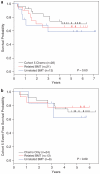Long-term follow-up of imatinib in pediatric Philadelphia chromosome-positive acute lymphoblastic leukemia: Children's Oncology Group study AALL0031
- PMID: 24441288
- PMCID: PMC4282929
- DOI: 10.1038/leu.2014.30
Long-term follow-up of imatinib in pediatric Philadelphia chromosome-positive acute lymphoblastic leukemia: Children's Oncology Group study AALL0031
Abstract
We previously reported preliminary findings that post induction imatinib mesylate (340 mg/m(2)/day), in combination with intensive chemotherapy, resulted in outcomes similar to blood and marrow transplant (BMT) for pediatric patients with Philadelphia chromosome-positive (Ph+) acute lymphoblastic leukemia (ALL). We now report 5-year outcomes of imatinib plus intensive chemotherapy in 91 children (1-21 years) with and without allogeneic BMT (N=91). We explore the impacts of additional chromosomal abnormalities and minimal residual disease (MRD) by flow cytometry on outcomes. The 5-year disease-free survival was similar for Cohort 5 patients, treated with chemotherapy plus imatinib (70%±12%, n=28), sibling donor BMT patients (65%±11%, n=21) and unrelated donor BMT patients (59±15%; P=0.60, n=13). Patients with additional cytogenetic abnormalities had worse outcomes (P=0.05). End induction (pre-imatinib) MRD was not prognostic for Cohort 5 or allogeneic BMT patients, although limited by small numbers. The re-induction rate following relapse was similar to other higher-risk ALL groups. Longer-term follow-up confirms our initial observation of substantially good outcomes for children and adolescents with Ph+ ALL treated with imatinib plus intensive chemotherapy with no advantage for allogeneic BMT.
Figures



References
-
- Gaynon PS, Trigg ME, Heerema NA, Sensel MG, Sather HN, Hammond GD, et al. Children’s Cancer Group trials in childhood acute lymphoblastic leukemia: 1983-1995. Leukemia. 2000;14:2223–2233. - PubMed
-
- Maloney KW, Shuster JJ, Murphy S, Pullen J, Camitta BA. Long-term results of treatment studies for childhood acute lymphoblastic leukemia: Pediatric Oncology Group studies from 1986–1994. Leukemia. 2000;12:2276–2285. - PubMed
-
- Pui CH, Evans WE. Treatment of acute lymphoblastic leukemia. N Engl J Med. 2006;354:166–178. - PubMed
-
- Aricò M, Valsecchi MG, Camitta B, Schrappe M, Chessells J, Baruchel A, et al. Outcome of treatment in children with Philadelphia chromosome-positive acute lymphoblastic leukemia. N Engl J Med. 2000;342:998–1006. - PubMed
Publication types
MeSH terms
Substances
Grants and funding
LinkOut - more resources
Full Text Sources
Other Literature Sources
Medical

